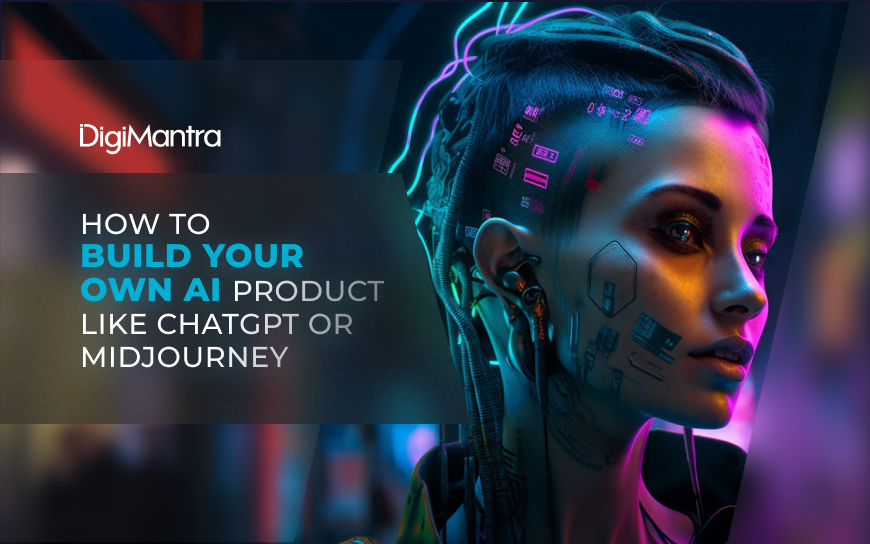The world is buzzing with AI. Whether it’s the mind-blowing visuals from AI image generators or the eerily human-like text from AI text generators, we’re living in a time where anyone with the right idea and team can build something game-changing.
So, if you've ever wondered how to create an AI product like ChatGPT or Midjourney, you're not alone. With thousands of searches every month for terms like ai art generator, ai picture generator, and ai image generator from text, it’s clear people are not just curious, they’re ready to build.
Let’s break down what it really takes to develop your own AI product, whether you're aiming for a writing assistant, an image creator, or something even more ambitious.
Step 1: Start With a Vision (and a Problem to Solve)

The most successful AI tools solve real-world problems. ChatGPT, for example, simplifies content creation, coding, and customer support. Midjourney, on the other hand, reimagines digital art with jaw-dropping creativity.
Before jumping into development, ask yourself:
- What problem does my AI solve?
- Who is it for - artists, marketers, students, businesses?
- What will make it unique in a sea of generative AI solutions?
Once you've nailed that, it's time to bring your idea to life.
Step 2: Understand the Tech Behind AI

To build your own AI product, you don’t need to be a PhD data scientist or an AI development services expert, but you do need a basic grasp of how it works.
Here’s a crash course:
- AI image generators like Midjourney are powered by models such as GANs (Generative Adversarial Networks) or diffusion models. These models learn from millions of images to create entirely new visuals.
- AI text generators like ChatGPT use transformer models, which learn to predict the next word in a sentence based on massive datasets.
- Whether you're working with AI generated text or images, it all starts with training a model on quality data. Your AI product's performance greatly hinges on the quality of the training data it receives.
Step 3: Use the Right Tools (Many Are Free & Open Source)

Here’s the exciting part: you don’t have to build everything from scratch. A lot of the tools used by major AI platforms and even the major AI development service providers are available to everyone. Open-source models like GPT-Neo, Stable Diffusion, or DALL-E 2 give you a powerful head start.
Here are Popular Open-Source Libraries you can use right now:
| Purpose | Tools / Libraries | Where to Find |
|---|---|---|
| Text Generation | GPT-Neo, GPT-J, LLaMA, Mistral | Hugging Face, Meta |
| Image Generation | Stable Diffusion, ControlNet, DALL·E Mini | Stability.ai, GitHub |
| Model Training | PyTorch, TensorFlow, JAX | GitHub, Google AI |
| APIs & Deployment | FastAPI, Docker, ONNX, Hugging Face Spaces | Open-source platforms |
| Experiment Tracking | Weights & Biases, MLflow | For monitoring and optimization |
These libraries are free, flexible, and backed by active communities. That means you can prototype quickly, test ideas, and pivot as needed, all without breaking the bank.
Step 4: Fine-Tune or Train Your Model
Once you’ve chosen your base model, you have two main options:

Fine-Tuning
Train an existing model with your custom dataset. For example, a GPT model fine-tuned on legal documents could help lawyers draft contracts faster.
Training from Scratch
Ideal if you have unique data and want full control, but it requires serious computing power and technical expertise.
Not sure what to choose? Many successful AI products use open-source models that are fine-tuned. It's the best of both worlds: cost-effective and tailored to your needs.
Step 5: Build a User Experience That Just Works
Even the most brilliant AI engine won’t go far if users can’t navigate it. Think of how intuitive tools like Midjourney (via Discord) or ChatGPT’s web app are. Your users shouldn’t need a tech degree to use your product.
Keep it simple. Add interactive prompts. Make the AI’s capabilities easy to explore, whether it’s an AI picture generator, an image-to-text app, or a text summarizer.
To sum up, keep these points in mind to make your AI product feel effortless and user-friendly right from the first click:
- Use clean, simple interfaces.
- Offer preset prompts or templates.
- Keep interactions feeling natural and quick.
- Provide visual feedback or previews.
If you’re creating an AI image generator from text, let users enter a prompt and pick styles. If it’s a text generator, give them formatting options or tone settings. Empower users without overwhelming them.

Step 6: Launch Smart, Then Keep Improving
AI development doesn't end at launch; it evolves with time and usage. Continuous training, user feedback, and iteration are key.
Here’s a helpful checklist:
- Collect user feedback continuously.
- Monitor accuracy, speed, and usage patterns.
- Re-educate your AI model with updated or augmented data.
- Run A/B tests to improve features or UX.
Remember: The best AI tools grow consistently. Top AI development services companies swear by platforms like MLflow or Weights & Biases in tracking model performance and experiments over time. Your product should grow and improve with every interaction.

Step 7: Plan for Scaling and Compliance
Your infrastructure requirements will naturally expand as your user base increases.
For Hosting & Compute Power:
- Use Google Cloud, Azure, and Amazon Web Services (AWS) for GPU support.
- Use RunPod, Replicate, and Paperspace for lighter deployment.
- Use Inference Endpoints readily available on Hugging Face to quickly host your AI models.

Don’t Forget Privacy & Ethics:
- Comply with laws like GDPR and CCPA.
- Be transparent about how user data is used.
- Regularly audit your AI for bias, toxicity, or misinformation.
Partnering with an experienced digital transformation company for AI development services can make scaling easier and safer.
Real Results: Why Businesses Are Investing in AI
This isn’t just tech for tech’s sake. Companies that adopt AI products and AI development services are seeing real returns:
- 15–30% productivity boost in content and customer service.
- Up to 3.7x ROI for every dollar spent on AI development.
- 57% faster turnaround times in support with generative AI tools.
- Improved personalization and better user engagement.
Whether you're building an AI art generator, a virtual assistant, or a smart search tool, AI is more than just innovative; it’s transformative.

Ready to Build? We Can Help
Let’s be real: building your own AI product can be complex. However, with the right collaborator by your side, the process doesn't have to feel overwhelming.
At DigiMantra, we specialize in AI development services that turn your vision into reality, whether you're building an AI art generator, an AI image generator from text, or the next big thing in AI-generated text platforms.
Our team of experts in the United States and globally can help you design, develop, and scale your AI product with cutting-edge tech and industry insights.
Ready to create the next ChatGPT or Midjourney?
Let’s build it together. Contact DigiMantra today for your custom generative AI solution.
Unlock Your Digital Potential Today!
Don’t just keep up, lead your industry.
Connect with DigiMantra’s top strategists and AI, web, and software experts to boost growth, streamline operations, and drive innovation.
Your transformation starts here.





